Strategic Plan for The Sydney Morning Herald
VerifiedAdded on 2022/11/13
|11
|2230
|165
AI Summary
The paper explores the strategic plan for The Sydney Morning Herald with a summary of internal and external analysis, key challenges, and strategic decision making. It analyzes the purpose of the newspaper and evaluates its strengths, weaknesses, opportunities, and threats. The paper also discusses Mintzberg's 5Ps of strategy and resources and capabilities of the newspaper.
Contribute Materials
Your contribution can guide someone’s learning journey. Share your
documents today.
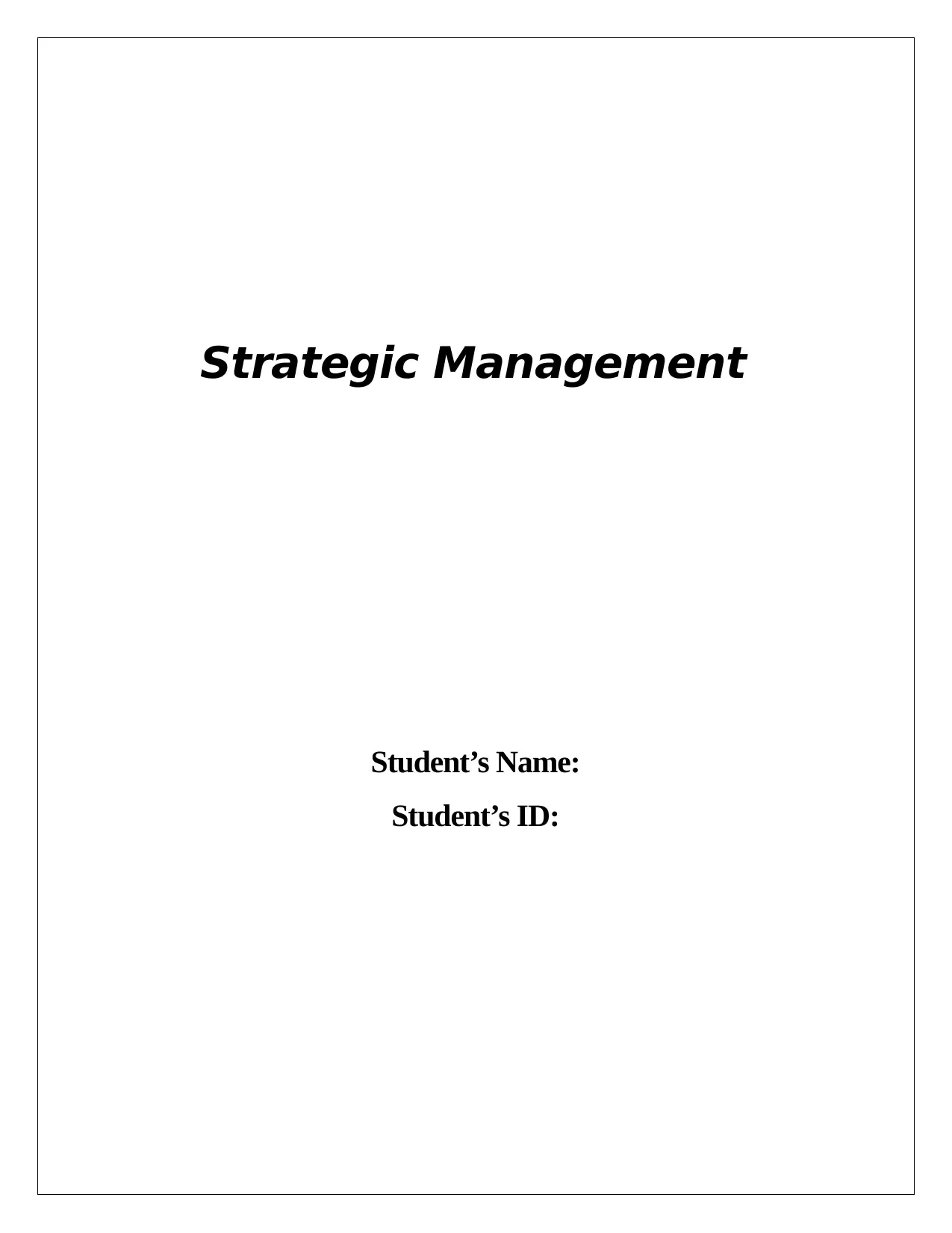
Strategic Management
Student’s Name:
Student’s ID:
Student’s Name:
Student’s ID:
Secure Best Marks with AI Grader
Need help grading? Try our AI Grader for instant feedback on your assignments.
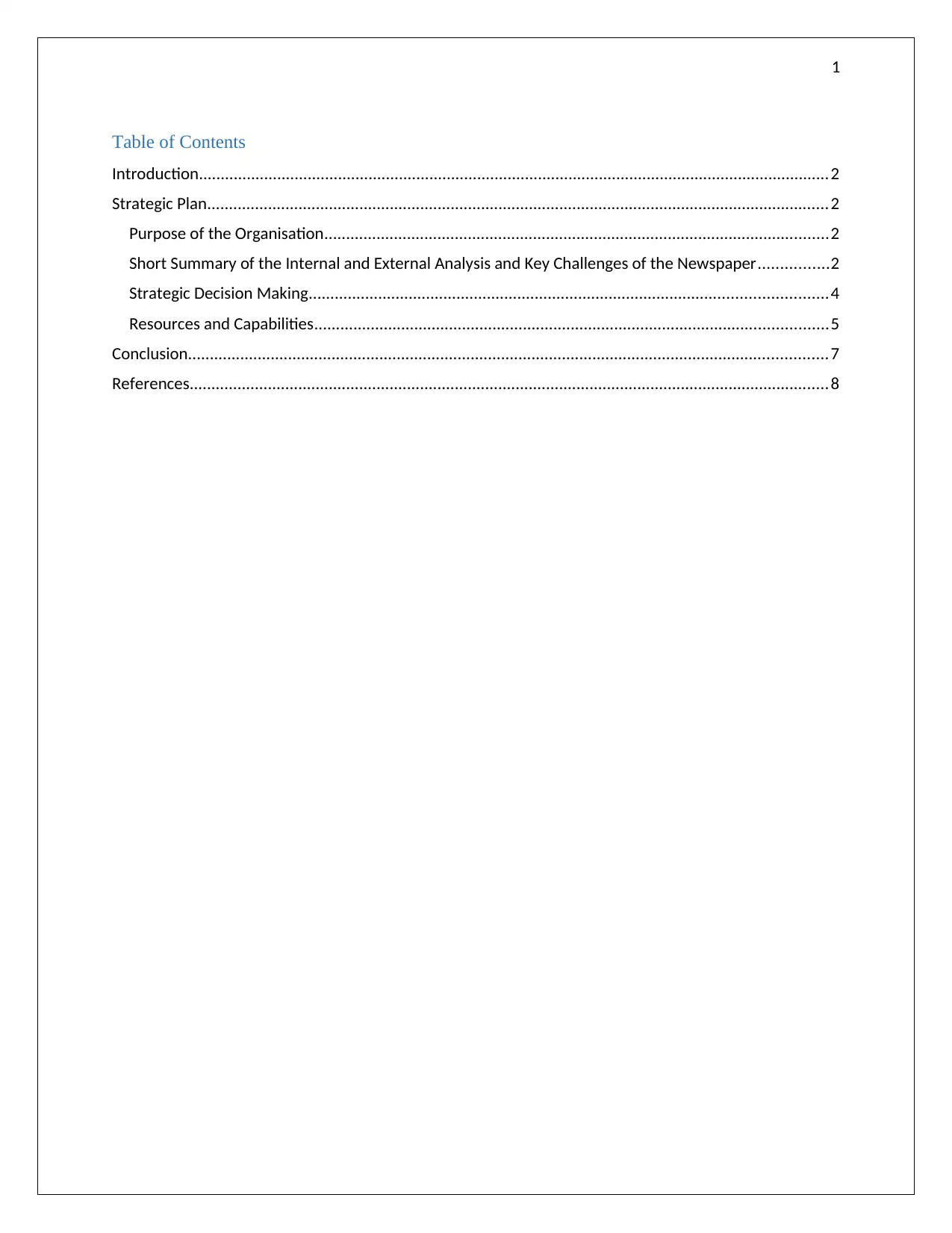
1
Table of Contents
Introduction.................................................................................................................................................2
Strategic Plan...............................................................................................................................................2
Purpose of the Organisation....................................................................................................................2
Short Summary of the Internal and External Analysis and Key Challenges of the Newspaper................2
Strategic Decision Making.......................................................................................................................4
Resources and Capabilities......................................................................................................................5
Conclusion...................................................................................................................................................7
References...................................................................................................................................................8
Table of Contents
Introduction.................................................................................................................................................2
Strategic Plan...............................................................................................................................................2
Purpose of the Organisation....................................................................................................................2
Short Summary of the Internal and External Analysis and Key Challenges of the Newspaper................2
Strategic Decision Making.......................................................................................................................4
Resources and Capabilities......................................................................................................................5
Conclusion...................................................................................................................................................7
References...................................................................................................................................................8
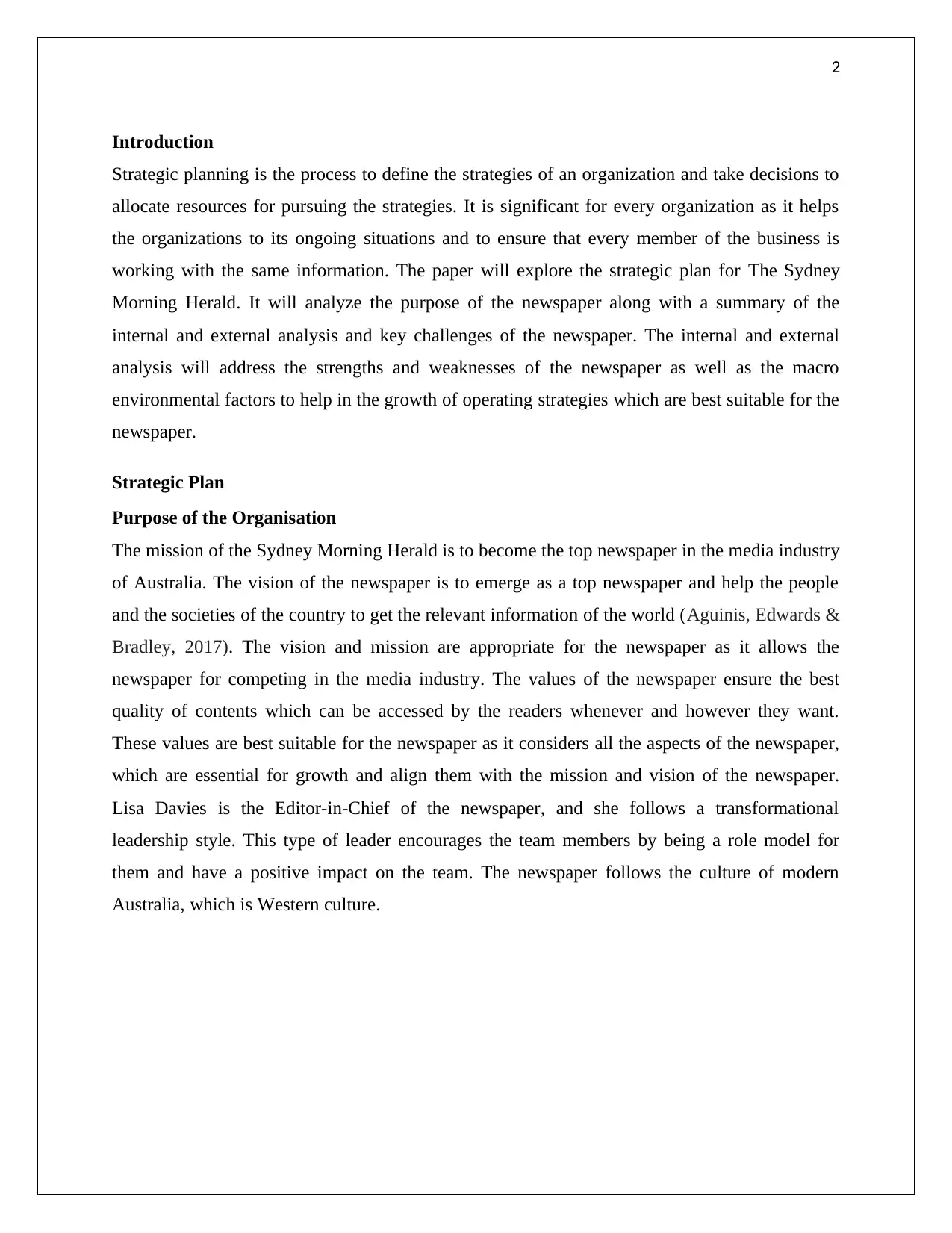
2
Introduction
Strategic planning is the process to define the strategies of an organization and take decisions to
allocate resources for pursuing the strategies. It is significant for every organization as it helps
the organizations to its ongoing situations and to ensure that every member of the business is
working with the same information. The paper will explore the strategic plan for The Sydney
Morning Herald. It will analyze the purpose of the newspaper along with a summary of the
internal and external analysis and key challenges of the newspaper. The internal and external
analysis will address the strengths and weaknesses of the newspaper as well as the macro
environmental factors to help in the growth of operating strategies which are best suitable for the
newspaper.
Strategic Plan
Purpose of the Organisation
The mission of the Sydney Morning Herald is to become the top newspaper in the media industry
of Australia. The vision of the newspaper is to emerge as a top newspaper and help the people
and the societies of the country to get the relevant information of the world (Aguinis, Edwards &
Bradley, 2017). The vision and mission are appropriate for the newspaper as it allows the
newspaper for competing in the media industry. The values of the newspaper ensure the best
quality of contents which can be accessed by the readers whenever and however they want.
These values are best suitable for the newspaper as it considers all the aspects of the newspaper,
which are essential for growth and align them with the mission and vision of the newspaper.
Lisa Davies is the Editor-in-Chief of the newspaper, and she follows a transformational
leadership style. This type of leader encourages the team members by being a role model for
them and have a positive impact on the team. The newspaper follows the culture of modern
Australia, which is Western culture.
Introduction
Strategic planning is the process to define the strategies of an organization and take decisions to
allocate resources for pursuing the strategies. It is significant for every organization as it helps
the organizations to its ongoing situations and to ensure that every member of the business is
working with the same information. The paper will explore the strategic plan for The Sydney
Morning Herald. It will analyze the purpose of the newspaper along with a summary of the
internal and external analysis and key challenges of the newspaper. The internal and external
analysis will address the strengths and weaknesses of the newspaper as well as the macro
environmental factors to help in the growth of operating strategies which are best suitable for the
newspaper.
Strategic Plan
Purpose of the Organisation
The mission of the Sydney Morning Herald is to become the top newspaper in the media industry
of Australia. The vision of the newspaper is to emerge as a top newspaper and help the people
and the societies of the country to get the relevant information of the world (Aguinis, Edwards &
Bradley, 2017). The vision and mission are appropriate for the newspaper as it allows the
newspaper for competing in the media industry. The values of the newspaper ensure the best
quality of contents which can be accessed by the readers whenever and however they want.
These values are best suitable for the newspaper as it considers all the aspects of the newspaper,
which are essential for growth and align them with the mission and vision of the newspaper.
Lisa Davies is the Editor-in-Chief of the newspaper, and she follows a transformational
leadership style. This type of leader encourages the team members by being a role model for
them and have a positive impact on the team. The newspaper follows the culture of modern
Australia, which is Western culture.
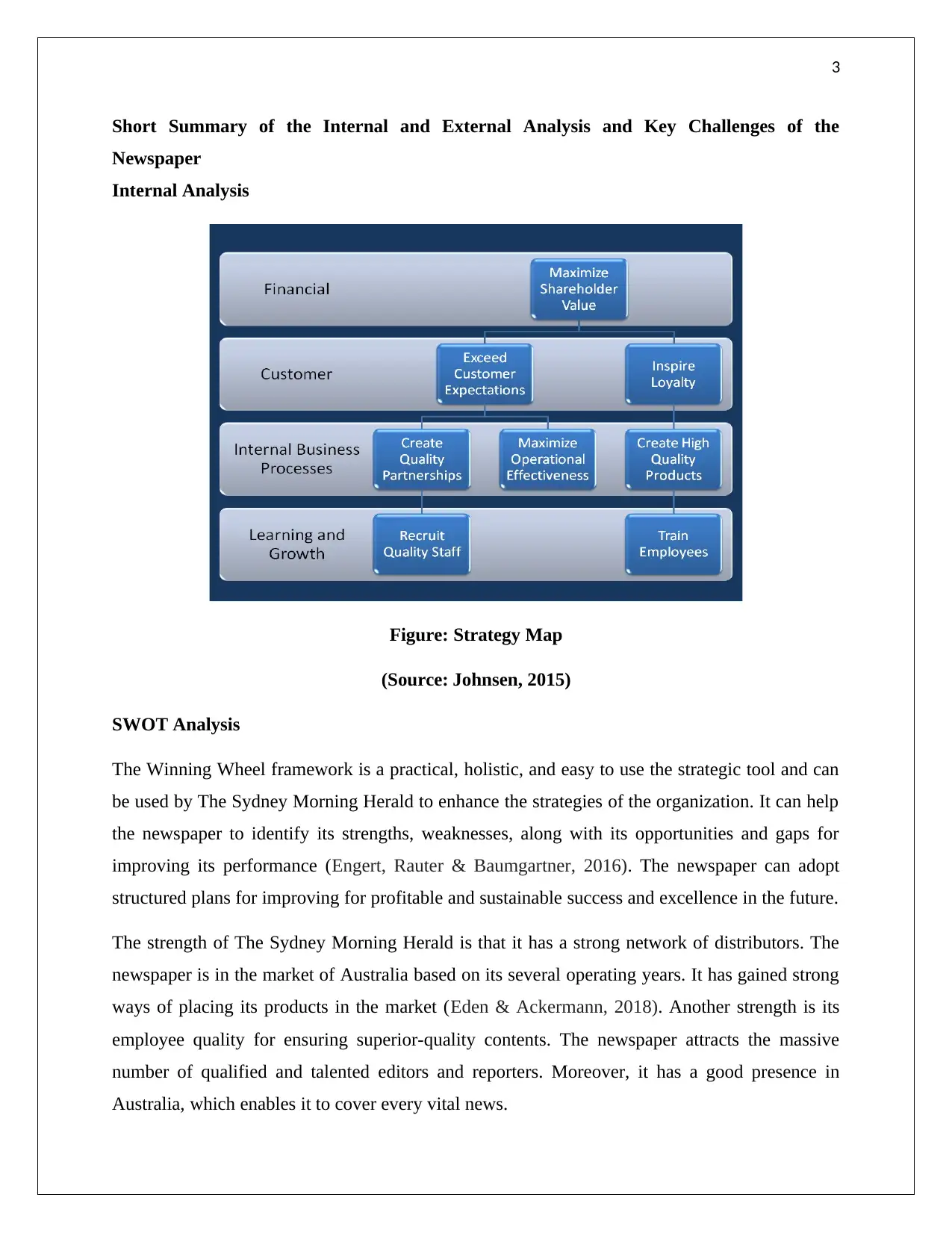
3
Short Summary of the Internal and External Analysis and Key Challenges of the
Newspaper
Internal Analysis
Figure: Strategy Map
(Source: Johnsen, 2015)
SWOT Analysis
The Winning Wheel framework is a practical, holistic, and easy to use the strategic tool and can
be used by The Sydney Morning Herald to enhance the strategies of the organization. It can help
the newspaper to identify its strengths, weaknesses, along with its opportunities and gaps for
improving its performance (Engert, Rauter & Baumgartner, 2016). The newspaper can adopt
structured plans for improving for profitable and sustainable success and excellence in the future.
The strength of The Sydney Morning Herald is that it has a strong network of distributors. The
newspaper is in the market of Australia based on its several operating years. It has gained strong
ways of placing its products in the market (Eden & Ackermann, 2018). Another strength is its
employee quality for ensuring superior-quality contents. The newspaper attracts the massive
number of qualified and talented editors and reporters. Moreover, it has a good presence in
Australia, which enables it to cover every vital news.
Short Summary of the Internal and External Analysis and Key Challenges of the
Newspaper
Internal Analysis
Figure: Strategy Map
(Source: Johnsen, 2015)
SWOT Analysis
The Winning Wheel framework is a practical, holistic, and easy to use the strategic tool and can
be used by The Sydney Morning Herald to enhance the strategies of the organization. It can help
the newspaper to identify its strengths, weaknesses, along with its opportunities and gaps for
improving its performance (Engert, Rauter & Baumgartner, 2016). The newspaper can adopt
structured plans for improving for profitable and sustainable success and excellence in the future.
The strength of The Sydney Morning Herald is that it has a strong network of distributors. The
newspaper is in the market of Australia based on its several operating years. It has gained strong
ways of placing its products in the market (Eden & Ackermann, 2018). Another strength is its
employee quality for ensuring superior-quality contents. The newspaper attracts the massive
number of qualified and talented editors and reporters. Moreover, it has a good presence in
Australia, which enables it to cover every vital news.
Secure Best Marks with AI Grader
Need help grading? Try our AI Grader for instant feedback on your assignments.
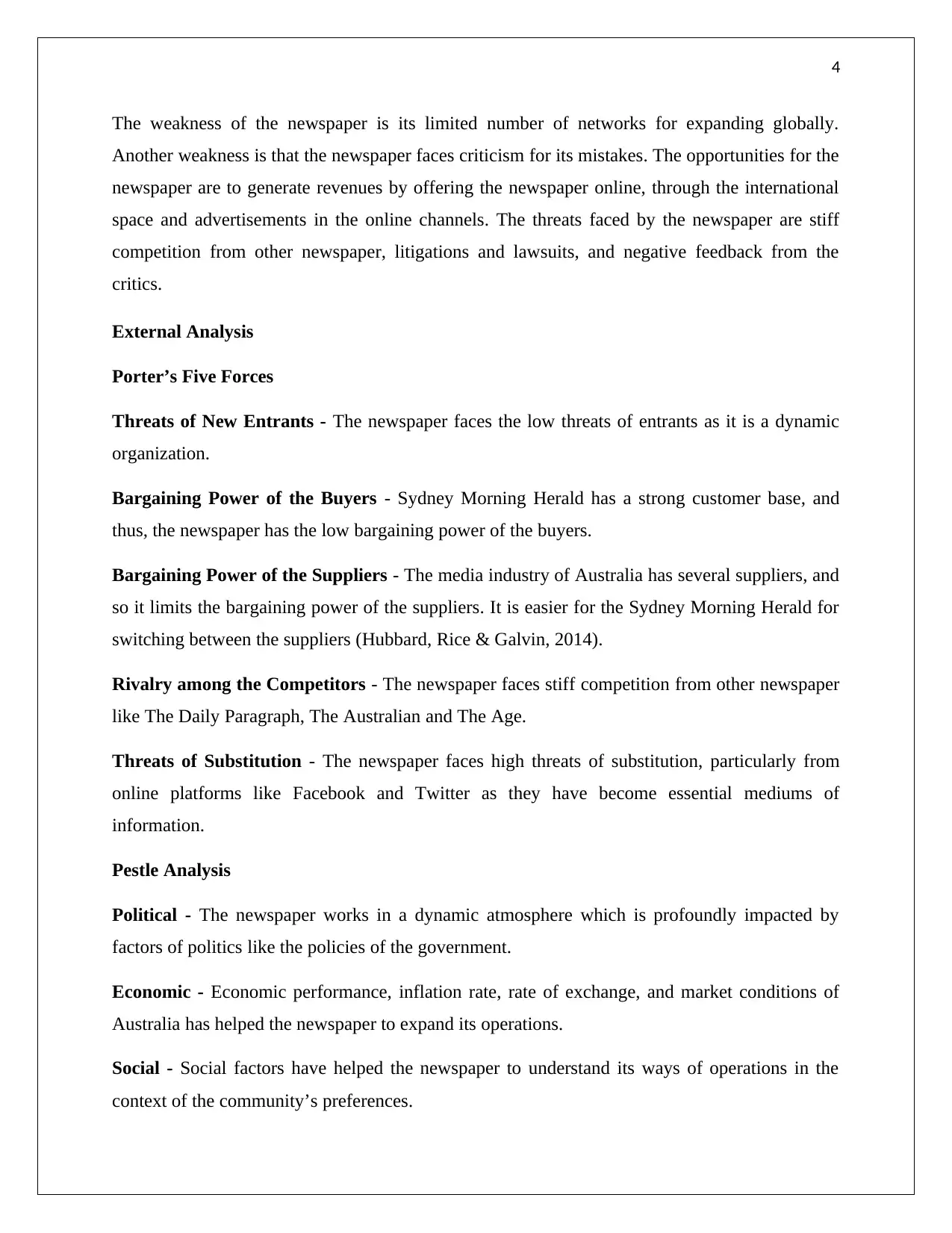
4
The weakness of the newspaper is its limited number of networks for expanding globally.
Another weakness is that the newspaper faces criticism for its mistakes. The opportunities for the
newspaper are to generate revenues by offering the newspaper online, through the international
space and advertisements in the online channels. The threats faced by the newspaper are stiff
competition from other newspaper, litigations and lawsuits, and negative feedback from the
critics.
External Analysis
Porter’s Five Forces
Threats of New Entrants - The newspaper faces the low threats of entrants as it is a dynamic
organization.
Bargaining Power of the Buyers - Sydney Morning Herald has a strong customer base, and
thus, the newspaper has the low bargaining power of the buyers.
Bargaining Power of the Suppliers - The media industry of Australia has several suppliers, and
so it limits the bargaining power of the suppliers. It is easier for the Sydney Morning Herald for
switching between the suppliers (Hubbard, Rice & Galvin, 2014).
Rivalry among the Competitors - The newspaper faces stiff competition from other newspaper
like The Daily Paragraph, The Australian and The Age.
Threats of Substitution - The newspaper faces high threats of substitution, particularly from
online platforms like Facebook and Twitter as they have become essential mediums of
information.
Pestle Analysis
Political - The newspaper works in a dynamic atmosphere which is profoundly impacted by
factors of politics like the policies of the government.
Economic - Economic performance, inflation rate, rate of exchange, and market conditions of
Australia has helped the newspaper to expand its operations.
Social - Social factors have helped the newspaper to understand its ways of operations in the
context of the community’s preferences.
The weakness of the newspaper is its limited number of networks for expanding globally.
Another weakness is that the newspaper faces criticism for its mistakes. The opportunities for the
newspaper are to generate revenues by offering the newspaper online, through the international
space and advertisements in the online channels. The threats faced by the newspaper are stiff
competition from other newspaper, litigations and lawsuits, and negative feedback from the
critics.
External Analysis
Porter’s Five Forces
Threats of New Entrants - The newspaper faces the low threats of entrants as it is a dynamic
organization.
Bargaining Power of the Buyers - Sydney Morning Herald has a strong customer base, and
thus, the newspaper has the low bargaining power of the buyers.
Bargaining Power of the Suppliers - The media industry of Australia has several suppliers, and
so it limits the bargaining power of the suppliers. It is easier for the Sydney Morning Herald for
switching between the suppliers (Hubbard, Rice & Galvin, 2014).
Rivalry among the Competitors - The newspaper faces stiff competition from other newspaper
like The Daily Paragraph, The Australian and The Age.
Threats of Substitution - The newspaper faces high threats of substitution, particularly from
online platforms like Facebook and Twitter as they have become essential mediums of
information.
Pestle Analysis
Political - The newspaper works in a dynamic atmosphere which is profoundly impacted by
factors of politics like the policies of the government.
Economic - Economic performance, inflation rate, rate of exchange, and market conditions of
Australia has helped the newspaper to expand its operations.
Social - Social factors have helped the newspaper to understand its ways of operations in the
context of the community’s preferences.
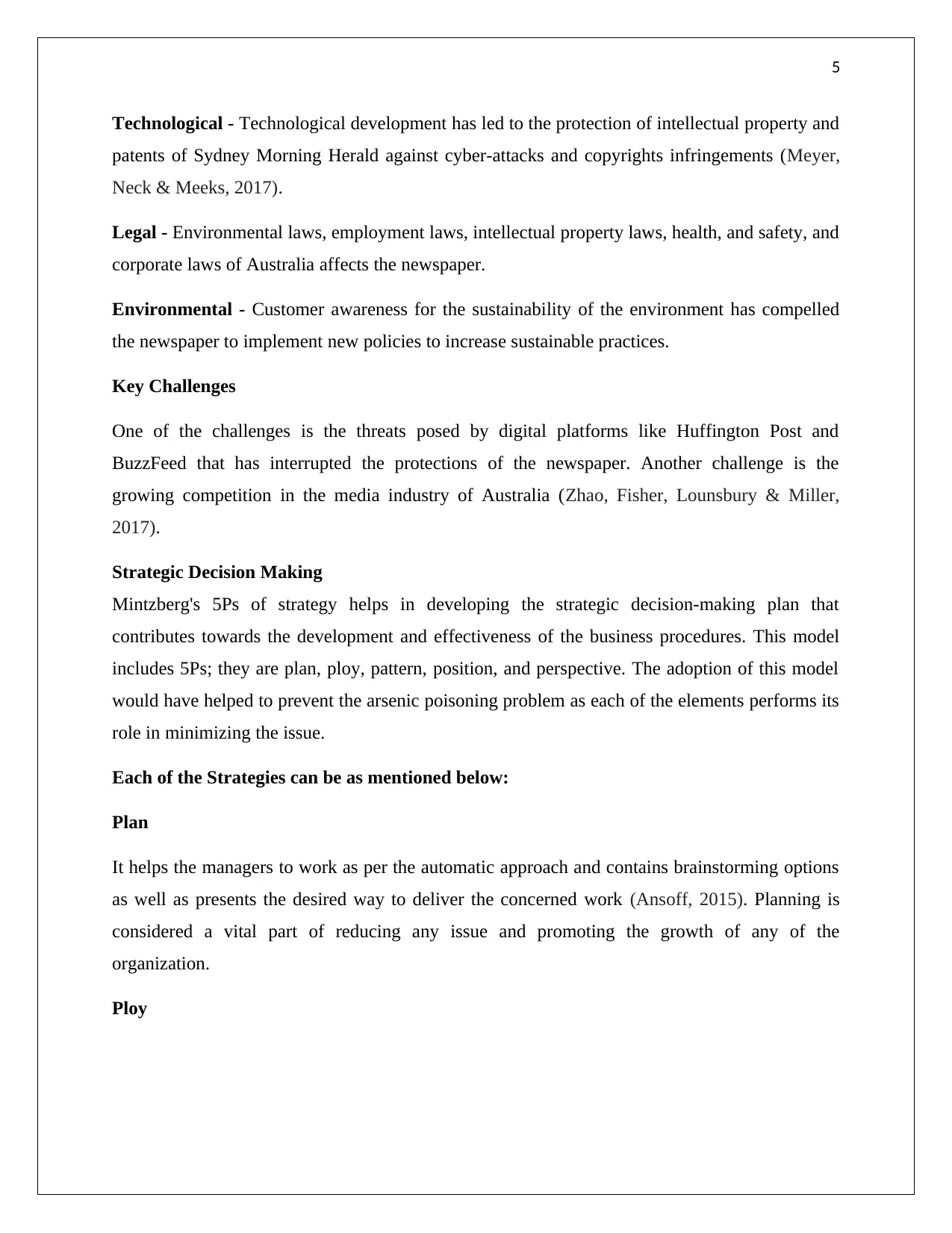
5
Technological - Technological development has led to the protection of intellectual property and
patents of Sydney Morning Herald against cyber-attacks and copyrights infringements (Meyer,
Neck & Meeks, 2017).
Legal - Environmental laws, employment laws, intellectual property laws, health, and safety, and
corporate laws of Australia affects the newspaper.
Environmental - Customer awareness for the sustainability of the environment has compelled
the newspaper to implement new policies to increase sustainable practices.
Key Challenges
One of the challenges is the threats posed by digital platforms like Huffington Post and
BuzzFeed that has interrupted the protections of the newspaper. Another challenge is the
growing competition in the media industry of Australia (Zhao, Fisher, Lounsbury & Miller,
2017).
Strategic Decision Making
Mintzberg's 5Ps of strategy helps in developing the strategic decision-making plan that
contributes towards the development and effectiveness of the business procedures. This model
includes 5Ps; they are plan, ploy, pattern, position, and perspective. The adoption of this model
would have helped to prevent the arsenic poisoning problem as each of the elements performs its
role in minimizing the issue.
Each of the Strategies can be as mentioned below:
Plan
It helps the managers to work as per the automatic approach and contains brainstorming options
as well as presents the desired way to deliver the concerned work (Ansoff, 2015). Planning is
considered a vital part of reducing any issue and promoting the growth of any of the
organization.
Ploy
Technological - Technological development has led to the protection of intellectual property and
patents of Sydney Morning Herald against cyber-attacks and copyrights infringements (Meyer,
Neck & Meeks, 2017).
Legal - Environmental laws, employment laws, intellectual property laws, health, and safety, and
corporate laws of Australia affects the newspaper.
Environmental - Customer awareness for the sustainability of the environment has compelled
the newspaper to implement new policies to increase sustainable practices.
Key Challenges
One of the challenges is the threats posed by digital platforms like Huffington Post and
BuzzFeed that has interrupted the protections of the newspaper. Another challenge is the
growing competition in the media industry of Australia (Zhao, Fisher, Lounsbury & Miller,
2017).
Strategic Decision Making
Mintzberg's 5Ps of strategy helps in developing the strategic decision-making plan that
contributes towards the development and effectiveness of the business procedures. This model
includes 5Ps; they are plan, ploy, pattern, position, and perspective. The adoption of this model
would have helped to prevent the arsenic poisoning problem as each of the elements performs its
role in minimizing the issue.
Each of the Strategies can be as mentioned below:
Plan
It helps the managers to work as per the automatic approach and contains brainstorming options
as well as presents the desired way to deliver the concerned work (Ansoff, 2015). Planning is
considered a vital part of reducing any issue and promoting the growth of any of the
organization.
Ploy
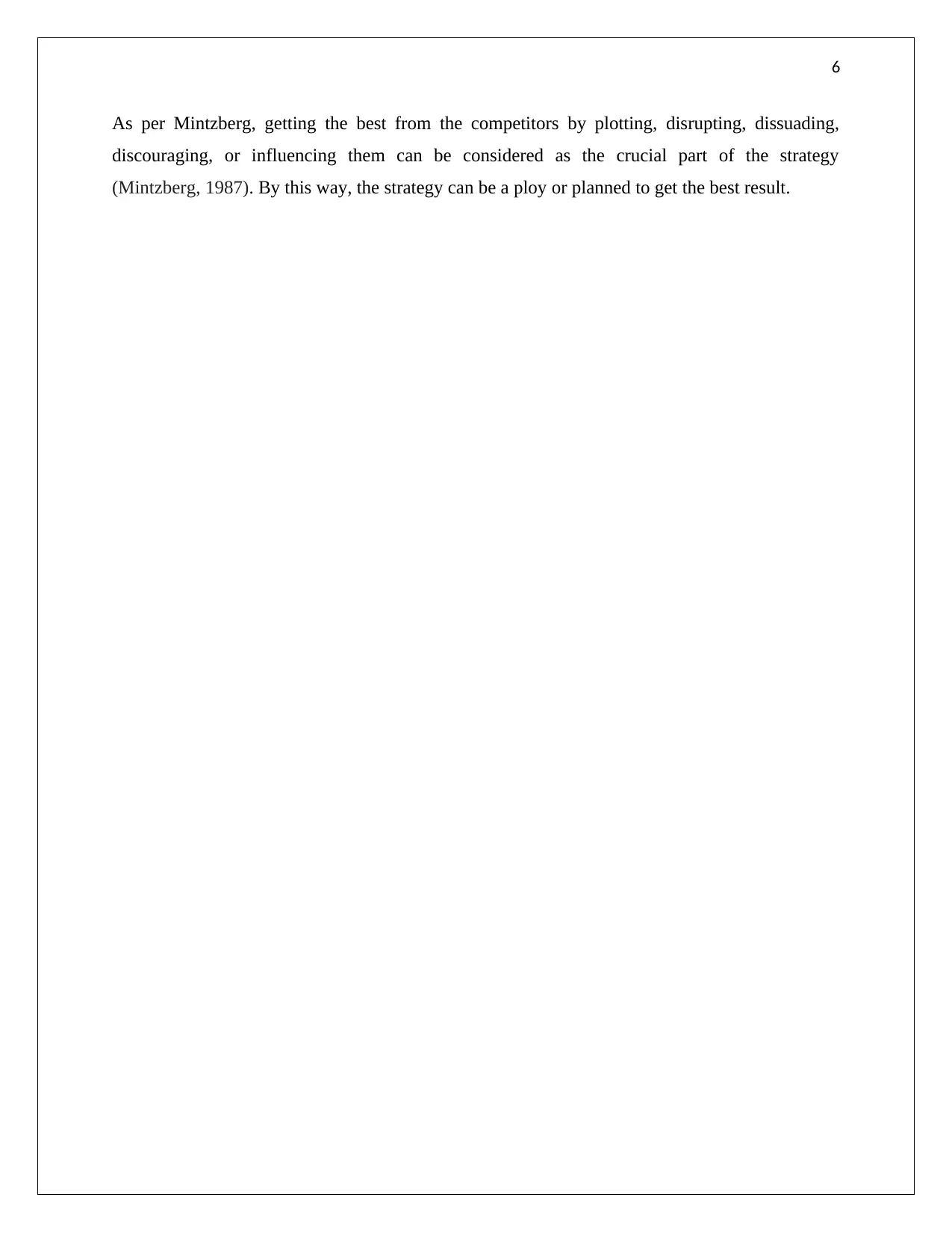
6
As per Mintzberg, getting the best from the competitors by plotting, disrupting, dissuading,
discouraging, or influencing them can be considered as the crucial part of the strategy
(Mintzberg, 1987). By this way, the strategy can be a ploy or planned to get the best result.
As per Mintzberg, getting the best from the competitors by plotting, disrupting, dissuading,
discouraging, or influencing them can be considered as the crucial part of the strategy
(Mintzberg, 1987). By this way, the strategy can be a ploy or planned to get the best result.
Paraphrase This Document
Need a fresh take? Get an instant paraphrase of this document with our AI Paraphraser
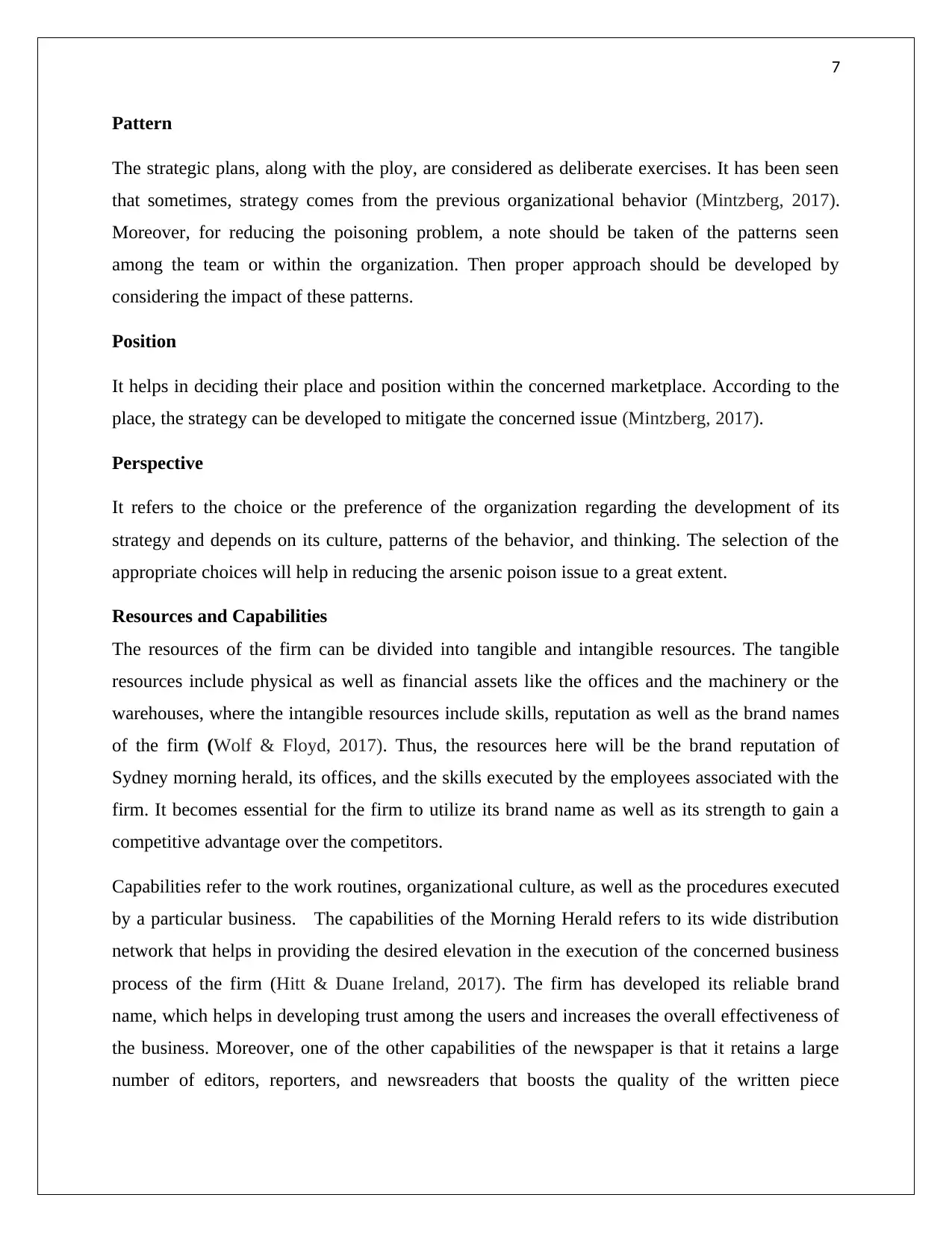
7
Pattern
The strategic plans, along with the ploy, are considered as deliberate exercises. It has been seen
that sometimes, strategy comes from the previous organizational behavior (Mintzberg, 2017).
Moreover, for reducing the poisoning problem, a note should be taken of the patterns seen
among the team or within the organization. Then proper approach should be developed by
considering the impact of these patterns.
Position
It helps in deciding their place and position within the concerned marketplace. According to the
place, the strategy can be developed to mitigate the concerned issue (Mintzberg, 2017).
Perspective
It refers to the choice or the preference of the organization regarding the development of its
strategy and depends on its culture, patterns of the behavior, and thinking. The selection of the
appropriate choices will help in reducing the arsenic poison issue to a great extent.
Resources and Capabilities
The resources of the firm can be divided into tangible and intangible resources. The tangible
resources include physical as well as financial assets like the offices and the machinery or the
warehouses, where the intangible resources include skills, reputation as well as the brand names
of the firm (Wolf & Floyd, 2017). Thus, the resources here will be the brand reputation of
Sydney morning herald, its offices, and the skills executed by the employees associated with the
firm. It becomes essential for the firm to utilize its brand name as well as its strength to gain a
competitive advantage over the competitors.
Capabilities refer to the work routines, organizational culture, as well as the procedures executed
by a particular business. The capabilities of the Morning Herald refers to its wide distribution
network that helps in providing the desired elevation in the execution of the concerned business
process of the firm (Hitt & Duane Ireland, 2017). The firm has developed its reliable brand
name, which helps in developing trust among the users and increases the overall effectiveness of
the business. Moreover, one of the other capabilities of the newspaper is that it retains a large
number of editors, reporters, and newsreaders that boosts the quality of the written piece
Pattern
The strategic plans, along with the ploy, are considered as deliberate exercises. It has been seen
that sometimes, strategy comes from the previous organizational behavior (Mintzberg, 2017).
Moreover, for reducing the poisoning problem, a note should be taken of the patterns seen
among the team or within the organization. Then proper approach should be developed by
considering the impact of these patterns.
Position
It helps in deciding their place and position within the concerned marketplace. According to the
place, the strategy can be developed to mitigate the concerned issue (Mintzberg, 2017).
Perspective
It refers to the choice or the preference of the organization regarding the development of its
strategy and depends on its culture, patterns of the behavior, and thinking. The selection of the
appropriate choices will help in reducing the arsenic poison issue to a great extent.
Resources and Capabilities
The resources of the firm can be divided into tangible and intangible resources. The tangible
resources include physical as well as financial assets like the offices and the machinery or the
warehouses, where the intangible resources include skills, reputation as well as the brand names
of the firm (Wolf & Floyd, 2017). Thus, the resources here will be the brand reputation of
Sydney morning herald, its offices, and the skills executed by the employees associated with the
firm. It becomes essential for the firm to utilize its brand name as well as its strength to gain a
competitive advantage over the competitors.
Capabilities refer to the work routines, organizational culture, as well as the procedures executed
by a particular business. The capabilities of the Morning Herald refers to its wide distribution
network that helps in providing the desired elevation in the execution of the concerned business
process of the firm (Hitt & Duane Ireland, 2017). The firm has developed its reliable brand
name, which helps in developing trust among the users and increases the overall effectiveness of
the business. Moreover, one of the other capabilities of the newspaper is that it retains a large
number of editors, reporters, and newsreaders that boosts the quality of the written piece
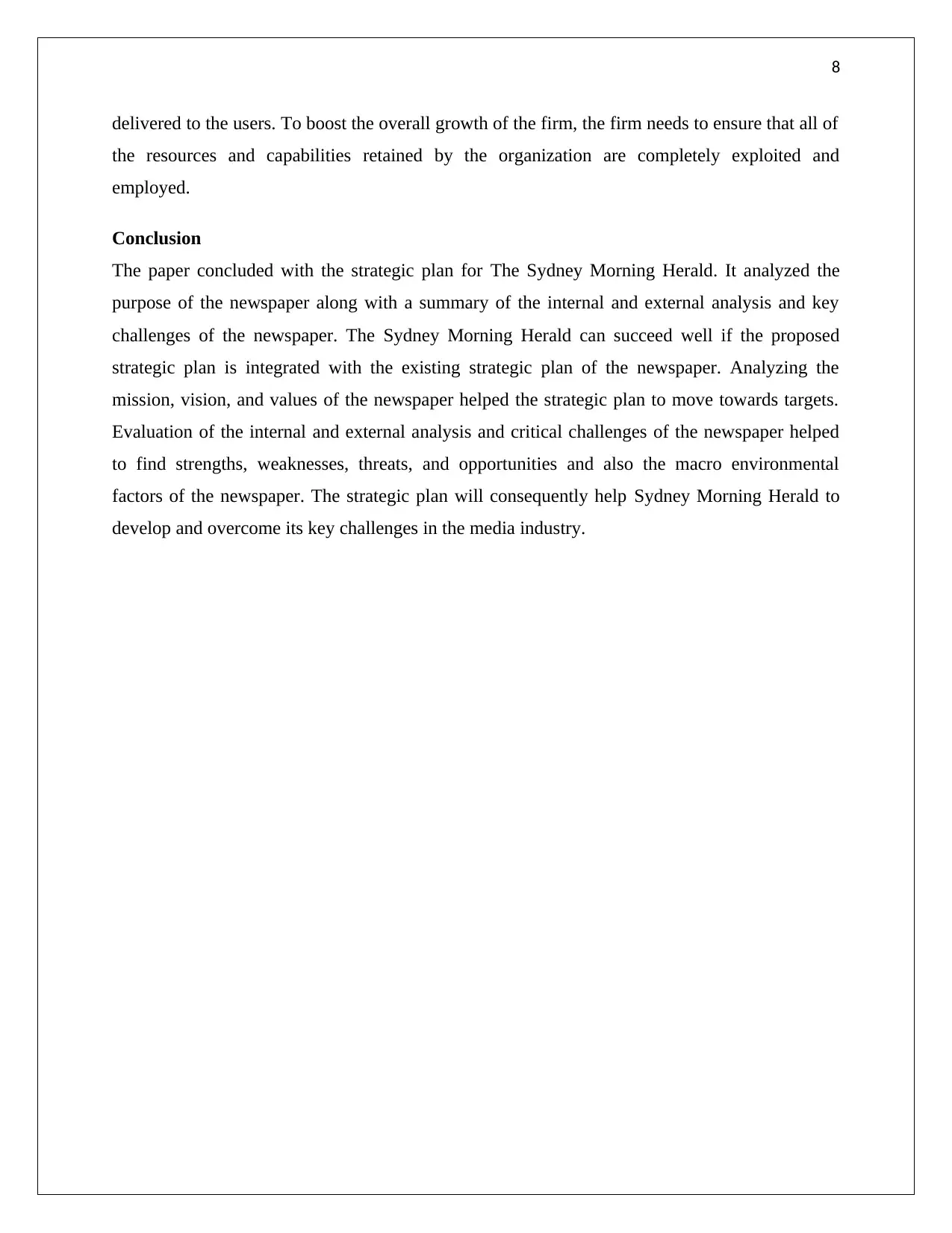
8
delivered to the users. To boost the overall growth of the firm, the firm needs to ensure that all of
the resources and capabilities retained by the organization are completely exploited and
employed.
Conclusion
The paper concluded with the strategic plan for The Sydney Morning Herald. It analyzed the
purpose of the newspaper along with a summary of the internal and external analysis and key
challenges of the newspaper. The Sydney Morning Herald can succeed well if the proposed
strategic plan is integrated with the existing strategic plan of the newspaper. Analyzing the
mission, vision, and values of the newspaper helped the strategic plan to move towards targets.
Evaluation of the internal and external analysis and critical challenges of the newspaper helped
to find strengths, weaknesses, threats, and opportunities and also the macro environmental
factors of the newspaper. The strategic plan will consequently help Sydney Morning Herald to
develop and overcome its key challenges in the media industry.
delivered to the users. To boost the overall growth of the firm, the firm needs to ensure that all of
the resources and capabilities retained by the organization are completely exploited and
employed.
Conclusion
The paper concluded with the strategic plan for The Sydney Morning Herald. It analyzed the
purpose of the newspaper along with a summary of the internal and external analysis and key
challenges of the newspaper. The Sydney Morning Herald can succeed well if the proposed
strategic plan is integrated with the existing strategic plan of the newspaper. Analyzing the
mission, vision, and values of the newspaper helped the strategic plan to move towards targets.
Evaluation of the internal and external analysis and critical challenges of the newspaper helped
to find strengths, weaknesses, threats, and opportunities and also the macro environmental
factors of the newspaper. The strategic plan will consequently help Sydney Morning Herald to
develop and overcome its key challenges in the media industry.
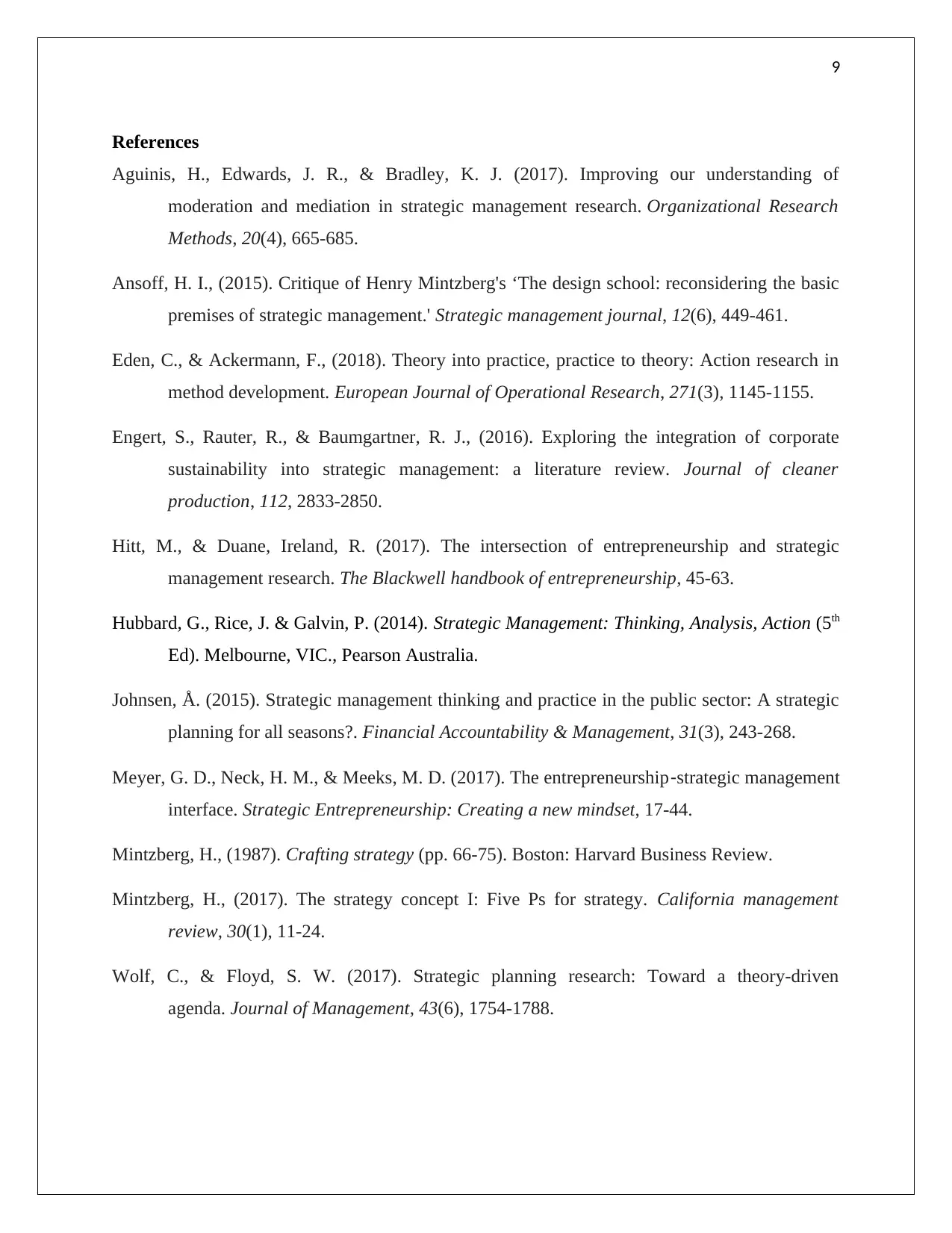
9
References
Aguinis, H., Edwards, J. R., & Bradley, K. J. (2017). Improving our understanding of
moderation and mediation in strategic management research. Organizational Research
Methods, 20(4), 665-685.
Ansoff, H. I., (2015). Critique of Henry Mintzberg's ‘The design school: reconsidering the basic
premises of strategic management.' Strategic management journal, 12(6), 449-461.
Eden, C., & Ackermann, F., (2018). Theory into practice, practice to theory: Action research in
method development. European Journal of Operational Research, 271(3), 1145-1155.
Engert, S., Rauter, R., & Baumgartner, R. J., (2016). Exploring the integration of corporate
sustainability into strategic management: a literature review. Journal of cleaner
production, 112, 2833-2850.
Hitt, M., & Duane, Ireland, R. (2017). The intersection of entrepreneurship and strategic
management research. The Blackwell handbook of entrepreneurship, 45-63.
Hubbard, G., Rice, J. & Galvin, P. (2014). Strategic Management: Thinking, Analysis, Action (5th
Ed). Melbourne, VIC., Pearson Australia.
Johnsen, Å. (2015). Strategic management thinking and practice in the public sector: A strategic
planning for all seasons?. Financial Accountability & Management, 31(3), 243-268.
Meyer, G. D., Neck, H. M., & Meeks, M. D. (2017). The entrepreneurship‐strategic management
interface. Strategic Entrepreneurship: Creating a new mindset, 17-44.
Mintzberg, H., (1987). Crafting strategy (pp. 66-75). Boston: Harvard Business Review.
Mintzberg, H., (2017). The strategy concept I: Five Ps for strategy. California management
review, 30(1), 11-24.
Wolf, C., & Floyd, S. W. (2017). Strategic planning research: Toward a theory-driven
agenda. Journal of Management, 43(6), 1754-1788.
References
Aguinis, H., Edwards, J. R., & Bradley, K. J. (2017). Improving our understanding of
moderation and mediation in strategic management research. Organizational Research
Methods, 20(4), 665-685.
Ansoff, H. I., (2015). Critique of Henry Mintzberg's ‘The design school: reconsidering the basic
premises of strategic management.' Strategic management journal, 12(6), 449-461.
Eden, C., & Ackermann, F., (2018). Theory into practice, practice to theory: Action research in
method development. European Journal of Operational Research, 271(3), 1145-1155.
Engert, S., Rauter, R., & Baumgartner, R. J., (2016). Exploring the integration of corporate
sustainability into strategic management: a literature review. Journal of cleaner
production, 112, 2833-2850.
Hitt, M., & Duane, Ireland, R. (2017). The intersection of entrepreneurship and strategic
management research. The Blackwell handbook of entrepreneurship, 45-63.
Hubbard, G., Rice, J. & Galvin, P. (2014). Strategic Management: Thinking, Analysis, Action (5th
Ed). Melbourne, VIC., Pearson Australia.
Johnsen, Å. (2015). Strategic management thinking and practice in the public sector: A strategic
planning for all seasons?. Financial Accountability & Management, 31(3), 243-268.
Meyer, G. D., Neck, H. M., & Meeks, M. D. (2017). The entrepreneurship‐strategic management
interface. Strategic Entrepreneurship: Creating a new mindset, 17-44.
Mintzberg, H., (1987). Crafting strategy (pp. 66-75). Boston: Harvard Business Review.
Mintzberg, H., (2017). The strategy concept I: Five Ps for strategy. California management
review, 30(1), 11-24.
Wolf, C., & Floyd, S. W. (2017). Strategic planning research: Toward a theory-driven
agenda. Journal of Management, 43(6), 1754-1788.
Secure Best Marks with AI Grader
Need help grading? Try our AI Grader for instant feedback on your assignments.
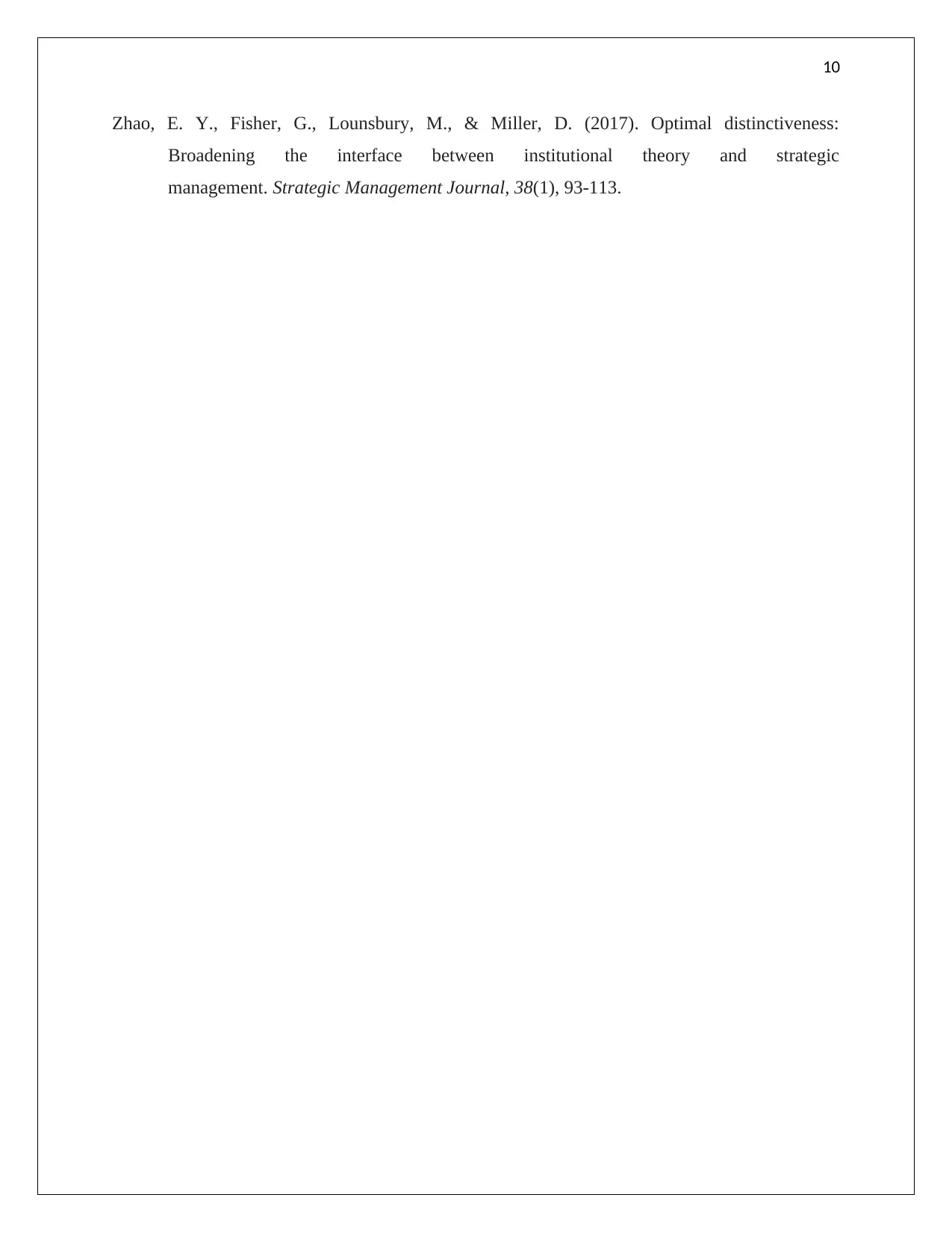
10
Zhao, E. Y., Fisher, G., Lounsbury, M., & Miller, D. (2017). Optimal distinctiveness:
Broadening the interface between institutional theory and strategic
management. Strategic Management Journal, 38(1), 93-113.
Zhao, E. Y., Fisher, G., Lounsbury, M., & Miller, D. (2017). Optimal distinctiveness:
Broadening the interface between institutional theory and strategic
management. Strategic Management Journal, 38(1), 93-113.
1 out of 11
Related Documents
Your All-in-One AI-Powered Toolkit for Academic Success.
+13062052269
info@desklib.com
Available 24*7 on WhatsApp / Email
![[object Object]](/_next/static/media/star-bottom.7253800d.svg)
Unlock your academic potential
© 2024 | Zucol Services PVT LTD | All rights reserved.





